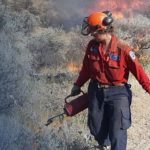Home »

Community Forest site of unique thinning project
 Cranbrook residents living near the Community Forest, or those hiking in it near the Mount Royal subdivision, may be wondering what’s up.
Cranbrook residents living near the Community Forest, or those hiking in it near the Mount Royal subdivision, may be wondering what’s up.
What’s up is what’s going down – as in thickets of tight forest undergrowth crunching beneath the 32 gnarling, grinding teeth of a masticating machine.
Aware of possible growing public concern or curiosity, those behind the work that began last week and will likely reach into next week decided to hold a media tour Friday, Jan. 27.
 Coordinating the forest thinning project, which will cover six hectares (13.2 acres) of thick forest along Cranbrook’s municipal boundary and the Crown land Community Forest, is the Rocky Mountain Trench Ecosystem Restoration Program (RMTERP). The Community Forest comprises about 1,800 ha.
Coordinating the forest thinning project, which will cover six hectares (13.2 acres) of thick forest along Cranbrook’s municipal boundary and the Crown land Community Forest, is the Rocky Mountain Trench Ecosystem Restoration Program (RMTERP). The Community Forest comprises about 1,800 ha.
There are several reasons for thinning the forest, explained Rocky Mountain Trench Natural Resources Society (Trench Society) coordinator Dan Murphy.
The tight spacing of the small trees, which are 70 plus years of age, makes the forest unusable for wildlife and creates extreme fire hazards, he said.
“The basic problem is we removed fire from the ecosystem,” Murphy said, explaining that the advent of technology following the First World War  allowed for successful battling of wildfires.
allowed for successful battling of wildfires.
“We’ve become really good at putting out forest fires,” he said, adding that such tactics as controlled
burns and thinning has allowed the RMTERP to help bring a variety of regional forests back to some semblance of former health. “The bottom line is there are too many trees.”
However, using the masticating machine, which is a small Cat fitted with a mulching attachment, provided by Invermere company JobKat Excavating, is a new and useful approach, Murphy said.

The type of forest stretching into the Community Forest, and elsewhere in the region, cannot be thinning with a controlled burn because of the potential severe risks, said Randy Harris, Ministry of Forests, Lands & Natural Resource Operations’ Ecosystem Restoration team leader.
“There is a high probability of ignition,” in the area being thinned, he said, noting that in itself would be enough reason to conduct wildland-urban interface work. Add in the extra grazing land that would be created for ungulates and more open forest for people to be able to enjoy and the work makes sense, he said.
 “We’re killing two birds with one stone,” Murphy said.
“We’re killing two birds with one stone,” Murphy said.
Added bonuses to using JobKat’s machine, with its single operator, are the work can be done more quickly and at less cost.
“We usually send out hand slashing crews,” Murphy said, explaining that the multi-person crew would then have to either burn or mulch the woody debris they’d cut down. And strict burning regulations add to the challenges with such a method.
While the operation was explained to the media, JobKat operator Denis

Rivard went to work, and quickly showed how on a good day he could thin five acres (more than two hectares) of forest.
His biggest obstacle? Rocks. “They’re my nemesis,” he said, explaining that a rock can break the teeth on the machine head.
He tore through a close thicket of trees, with trunk diameters ranging from one to 10 inches, or more, and spaced mere inches apart, and in a few seconds he mowed a 10 foot long strip. He stopped at a larger standing (dead) tree, and lifted the masticator. In a few seconds, the tree was shredded into pieces.
“It just rips the crap out of it!” Exclaimed Murphy.
Harris said there is little worry of the shredded debris left behind becoming fire hazards. “It will rot pretty quickly,” he said, and should fire break out, it would burn along the ground and not race wildly through the currently tight thickets of trees, some so thick deer could not pass through them.
Additionally, Harris pointed out that a fire moving through this section of forest would burn extremely hot and destroy the thin soil base. “It would be like a desert up here,” he said.

“There is less soil disturbance, which means less opportunity for invasive weeds to take hold, and it leaves no patches of burned ground that must be seeded with grass to reduce weed invasion. And mastication doesn’t produce smoke, eliminating the air quality issues that irritate people and restrict operating days,” a Trench Society press hand out explained.
On top of the other benefits mentioned, a thinner forest will help improve the overall health of the forest, reducing potential of insect infestation (beetles etc.).
RMTERP opted to work with JobKat, owned by Joe and Karen Cote of Wilmer, after holding test trials in October (2011).
“JobKat felled and chipped standing trees on Brewery Ridge near Fort Steele and in the Cranbrook Community Forest. The compact rig was also used to mulch slash piles on the Waldo Project site near Jaffray and at Eager Hills outside of Cranbrook. Results from the October trials were promising and Jobkat has since been contracted to continue masticating standing trees and slash piles through the winter, the Trench Society outlined.

Work began in the Community Forest in October but work was halted until winter ground conditions could be established.
In total, roughly 120,000 trees are expected to be cleared in the week-long operation. It sounds like a lot but the average hectare in the Community Forest contains 27,000 stems – with some having as many as 50,000 stems. The intent of the thinning project is to leave behind about 400 stems per ha.
“A few hundred years ago this was an area of grassland and stately, widely spaced trees. Nowadays it’s infested with doghair thickets of stunted trees with no value as timber products. As many as 50,000 trees are growing in a single hectare, choking each other out in a competition for water and nutrients. Such a dense canopy of trees also blocks out light, impairing growth of native grasses and shrubs,” the Trench Society release explained.
Also along for the tour was Grant Griffin of the Cranbrook Community Forest Society, who said his organization has conducted small thinning programs and was impressed with how efficiently and cleanly the mulching work was being done.

Along with being front and centre in a new way to thin forest, JobKat Excavating was also named the 2011 Aboriginal Business of the Year Award from the Kootenay Aboriginal Business Development Agency.
“We’ve had an exceptional year and are excited about our new venture into ecosystem restoration. We would like to thank Dan Murphy and the Rocky Mountain Trench Society as well as Max Andrew with the Ministry of Forest, Lands and Natural Resource Operations for giving us this opportunity,” said co-owner Joe Cote.
The 11-organization Trench Society is one of 24 citizen, First Nations, business and government groups comprising the RMTERP, which works to restore grassland/open forest ecosystems on Crown land, provincial/national parks, First Nations reserves and private conservation lands in an area stretching from Radium Hot Springs south to the US border.
Ian Cobb/e-KNOW







